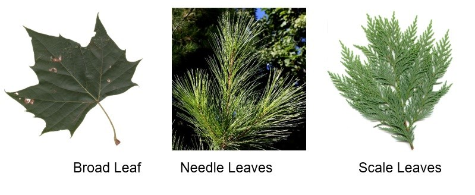Broad Leaf vs Needles vs Scale-like Leaves

This week in our plant identification series, we cover the different types of leaf structures that plants can have. Many of these leaf structures were developed to help plants survive specific environmental conditions (needles and scales are more common in hot and dry locations, while broadleaves tend to occur in locations with more moisture and moderate temperatures).
- Broadleaf- a tree or plant with broad, flat leaves. This group mainly includes deciduous plants (ones that lose their leaves every year); however, there are some exceptions, such as hollies, viburnums, and boxwood. As was discussed last week, the type of leaf and the shape can be used as an identification technique.
- Needles- a tree or plant that has leaves shaped like needles. These are common on evergreen plants; however, some deciduous plants have needles (Bald cypress, for example). Needles can be found individually (e.g., in spruce trees) or in bundles of two or more (e.g., in pine trees). The number of needles in a bundle and their length can be used as a plant identification technique for telling pine trees apart.
- Scale-like leaves- small, flat, overlapping structures that store food and water. They are found on evergreen plants that do not drop their leaves. Plants with scale-like leaves include Juniperus, Thuja (Arborvitae), and Chamaecyparis or White Cedar.

Have questions? Contact our office where our Horticulture Extension Agent will assist you with questions.
Phone: (316) 321-9660
Email: callae@ksu.edu